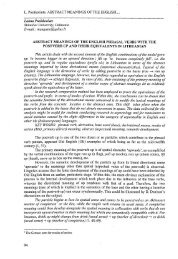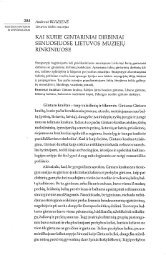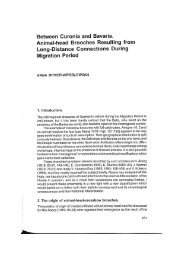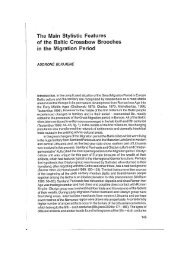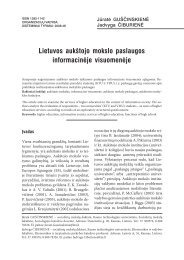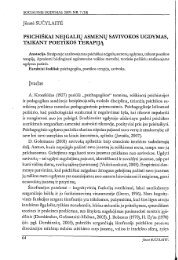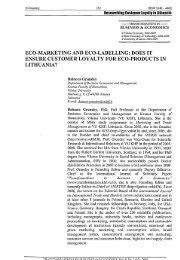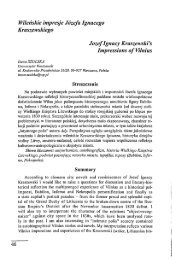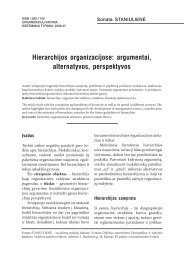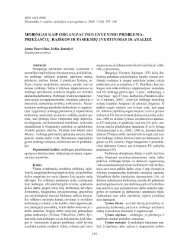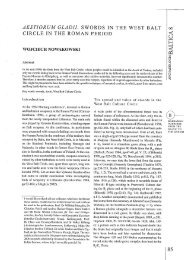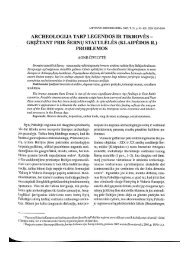ŽAGARĖS II (ŽVELGAIČIO) PILIAKALNIO IR KAPINYNO RADINIAI
ŽAGARĖS II (ŽVELGAIČIO) PILIAKALNIO IR KAPINYNO RADINIAI
ŽAGARĖS II (ŽVELGAIČIO) PILIAKALNIO IR KAPINYNO RADINIAI
You also want an ePaper? Increase the reach of your titles
YUMPU automatically turns print PDFs into web optimized ePapers that Google loves.
Livonian Rhymed Chronicle of 1272-1289. The<br />
land of Žagarė consisted of two castle-counties<br />
of Žagarė and Rakte and five counties with<br />
central villages of Martyniškiai, Budraičiai,<br />
Augstkalnes Priedulaji, Rukuižiai (?) and<br />
Stungiai (Fig. 41). Recently, the precise<br />
allocation of the boundary between Žagarė and<br />
Silenė lands is complicated.<br />
During the excavations two dating layers in<br />
the hillfort <strong>II</strong> of Žagarė have been discerned. The<br />
first layer traditionally is dated back to the 12th-<br />
14th century and is concerned with German castle,<br />
built in 1271 and having existed till the 14th<br />
century. In the 12th—13th century the hillfort was<br />
the centre of castle-county. The types of the scarce<br />
finds, nevertheless, show Žagarė as one of rather<br />
important centres of West Semigallia and a<br />
crossroad of trade-routes.<br />
The types of a major part of the 12th-14th<br />
century finds, especially the necklaces made of<br />
beads and bells found in Interwar period (Fig. 13),<br />
depict a very probable existence of possibly<br />
cremated burial ground, which has not been yet<br />
allocated.<br />
According to archaeological finds, the second<br />
layer should be dated back to the end of the 16th—<br />
the 17th century, as after the fires of the town and<br />
the manor in 1584 and 1586, the manor was<br />
moved, and thus can be related with the manor of<br />
Syrewiczowe (Sirewiczowe) and afterwards<br />
Umiastowsky, the owners of Old Žagarė.<br />
Already for a long time, since the late 19th—<br />
the early 20th century, by scholars it is proposed,<br />
that Lithuanian duke Žvelgaitis can be concerned<br />
with the land of Žagarė and the hillfort <strong>II</strong> of<br />
Žagarė. Some researchers do not support this<br />
statement. However, the spread of cremation in<br />
the late 12th-the early 13th century Semigallia<br />
affirms Lithuanian expansion to southern lands<br />
of Semigallians. In the Chronicle of Henricus de<br />
Lettis it is testified about a great disagreement<br />
between Viestardas, the duke of West Semigallia,<br />
and Žvelgaitis, the duke of East Semigallia and<br />
Lithuanians. Therefore, this statement might have<br />
a reasonable background.<br />
LIST OF TABLES<br />
Table 1. Statistical data of nails.<br />
Table 2. Statistical data of ridges of household<br />
pottery and tiles.<br />
Table 3. Statistical data of ridges of bottoms<br />
of household pottery and tiles.<br />
Table 4. Statistical data of walls of household<br />
pottery and pot tiles.<br />
LIST OF ILLUSTRATIONS<br />
Fig. 1. Žvelgaitis hill in the 4th decade of the<br />
20th century.<br />
Fig. 2. Žvelgaitis hill in 1938.<br />
Fig. 3. Hillfort <strong>II</strong> of Žagarė (Žvelgaitis) in<br />
1942.<br />
Fig. 4. Fragments of ceramics occasionally<br />
found in 1942.<br />
Fig. 5. Excavations in 1956.<br />
Fig. 6. Cultural layers of the 16th—17th century<br />
(in the depth of 15-20 cm), unearthed in the<br />
hillfort <strong>II</strong> of Žagarė (Žvelgaitis) in 1956.<br />
Fig. 7. Cultural layers, unearthed in 1956.<br />
Fig. 8. Cultural layers, unearthed in 1956.<br />
Fig. 9. Cultural layers, unearthed in 1956.<br />
Fig. 10. Cultural layers, unearthed in 1956.<br />
Fig. 11. Iron awls (1-2), a knife (3) and an<br />
oval-shape striker (4).<br />
Fig. 12. Iron spearheads.<br />
Fig. 13. Necklaces made of beads, bells.<br />
Fig. 14. Iron pins with eight-leaved clovershape<br />
head.<br />
Fig. 15. Penannular fibulae with zoomorphic<br />
terminals.<br />
Fig. 16. Round iron belt buckle (1) and bronze<br />
rings (2-4).<br />
Fig. 17. Iron spurs.<br />
Fig. 18. Pipes.<br />
Fig. 19. Fragments of glass vessels.<br />
Fig. 20. Fragments of bronze sheathings.<br />
Fig. 21. Coin, Ireland, Henry <strong>II</strong>I (1216-1272),<br />
penny, silver.<br />
Fig. 22. Coin, Germany, the County of Arnsberg,<br />
Gottfried <strong>II</strong>I (1235-1282), denarius, silver.



